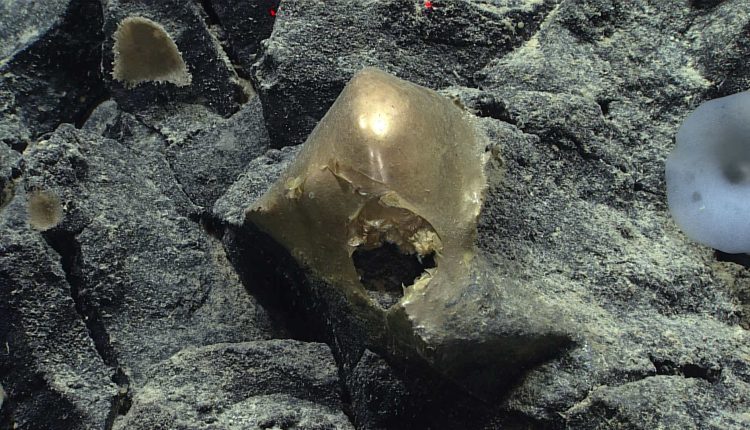NOAA’s Deep-Sea Mystery: The ‘Yellow Hat’ Organism
Exploring an Unidentified Deep-Sea Wonder

In an intriguing deep-sea discovery, researchers from the National Oceanic and Atmospheric Administration (NOAA) stumbled upon an enigmatic organism during a recent dive. Conducted at a depth of approximately 3,300 meters, or roughly 2 miles, the NOAA scientists were left bewildered by an unusual entity they initially dubbed the ‘yellow hat.’
This peculiar finding was encountered as the research team glided over a rocky outcrop in the ocean’s depths. Amidst a backdrop of white sponges, the specimen, measuring around 10 centimeters (4 inches) in width, was firmly attached to a rock. A small opening or tear near its base revealed an interior of similar coloration.
As the onboard videographers zoomed their cameras in for a closer look, the scientific community was presented with a puzzle. Initial hypotheses ranged from it being a deceased sponge attachment to coral or even an egg casing. Dr. Sam Candio, the NOAA Ocean Exploration researcher and expedition coordinator for the ongoing Seascape Alaska 5: Gulf of Alaska Remotely Operated Vehicle Exploration and Mapping expedition, expressed the sentiment of scientific wonder, stating, “Isn’t the deep sea so delightfully strange?”
Although the team was able to collect this ‘golden orb’ and transport it onto the research vessel, they remain unable to definitively classify it beyond confirming its biological origin. Dr. Candio remarked, “We likely won’t learn more until we are able to get it into a laboratory setting where we can continue to pull from the collective expertise of the scientific community with more sophisticated tools than we are able to maintain on the ship.” This intriguing discovery, while somewhat humbling for the researchers, serves as a stark reminder of the vast unknowns that still exist in our understanding of Earth’s oceans.
The mysterious specimen’s identity remains shrouded in uncertainty, with questions surrounding whether it belongs to a known species, represents a new species altogether, or possibly signifies an undocumented life stage of an existing species.
Dr. Candio emphasized the potential significance of such discoveries, stating, “New species have the potential to reveal new sources for medical therapies and vaccines, food, energy, and other societal benefits and knowledge.” Additionally, the data collected during this expedition will play a vital role in filling gaps in our understanding of this remote part of the planet, contributing to improved management and protection of these vital marine ecosystems. This extraordinary finding is a testament to the deep-sea’s capacity to astonish and inspire further exploration.
